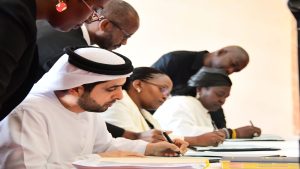Share
Uganda is writing a magnificent story of economic recovery and strategic vision in the heart of East Africa, typified by the impressive advancements in its oil and gas industry.

The Minister of Energy and Mineral Development, Ruth Nankabirwa, is the conductor of this grand symphony. Her latest briefing revealed a thorough update on important projects, signifying a turning point in the country’s quest for energy riches.
The Revolution of Refineries
Uganda’s midstream oil and gas activities are anchored by the much anticipated $4 billion refinery, which is at the vanguard of this transformative journey.
A Memorandum of Understanding (MoU) between the Ugandan government and Alpha MBM Investments LLC from the United Arab Emirates was formally signed on December 22, 2023, Minister Nankabirwa revealed with contagious joy.
This historic agreement establishes the parameters for discussion and cooperation, laying the groundwork for what seems to be an enormous partnership.
On January 16, 2024, the government and Alpha MBM Investments LLC began negotiating important business agreements. It is expected that the comprehensive talks would come to an end in the next three months, bringing hope and urgency to Uganda’s oil and gas sector.
After the Project Framework Agreement with the Albertine Graben Energy Consortium expired on June 30, 2023, the refinery project got further impetus.
President Yoweri Museveni then ordered a change to a public sector-led initiative, which rekindled enthusiasm and determination for the refinery’s completion.
In accordance with this direction, the Ministry of Energy and Mineral Development involved stakeholders in the strategic planning of the refinery project.
After a deluge of Expressions of Interest (EOIs) from prospective investors, Alpha MBM Investments LLC was selected for further review. Uganda’s aspirations to utilize its oil wealth for economic success are anchored by the refinery project, which has the potential to refine an astounding 60,000 barrels of oil per day.
EACOP: A Marvelous Cross-Border
Concurrently, the East African Crude Oil Pipeline (EACOP) has become a symbol of innovative infrastructure and regional collaboration.
EACOP began a voyage of revolutionary activities in January 2023 after obtaining its construction license under the Petroleum (Refining, Conversation, Transmission and Midstream Storage) Act, 2013.
Early civil works in Tanzania were initiated with the issuance of contracts for building and line pipes. The foundation for pipeline development was laid by the joint efforts of Nyanza Roads Ltd, JV Spec, and the China Petroleum Pipeline Engineering Company (CPP).
The project, which takes up about 2,740 acres in Uganda, affects 3,660 people, 177 of whom need houses for resettlement. The careful process of completing 91% of the compensation agreements and signing 95% of them highlights the dedication to equitable and inclusive development.
Notably, the pipeline’s first 100 kilometers successfully traveled from Dar es Salaam to the coating facility in Ishaka, Western Uganda, indicating both advancement and the connected momentum that is essential for the smooth operation of upstream projects like Tilenga and Kingfisher.
Upstream Superstars: Kingfisher and Tilenga
The Industrial Area is a furnace of invention that is revealed by the Tilenga project, the epicenter of advancement. More than 85 percent of this vast industrial miracle is attributed to contractors such as McDermott & SINOPEC, Schlumberger, China Oil Services Limited Uganda, ZPEB, and Vallourec.
Together, they are actively involved in many aspects of the project, driving the development of a Central Processing Facility with a 190,000 barrel capacity.
Concurrently, at Kingfisher, the development plan entails a Central Processing Facility (CPF) with a capacity of 40,000 barrels and 31 wells distributed among four well pads.
While on-site building and installation proceed in Bugoma, the Buhuka flats see the creation of a CPF, where design and procurement are managed in China.
Leading this revolutionary project are China Petroleum Engineering and Construction Corporation (CPECC) and China Offshore Oil Engineering Company (COOEC).
Ecological Responsibilities and Financial Effects
Minister Nankabirwa affirms with pride that Uganda has upheld the strictest industrial, legal, regulatory, and environmental standards since the historic oil discovery in 2006.
A major driver of the nation’s GDP, the industry has generated an astounding $8.6 billion in revenue and over 12,000 new jobs. This is a story of industrial development, but it’s also a symphony of economic improvement with long-term advantages over the next 25 years.
As Uganda approaches the momentous occasion of its first oil production in the upcoming year, the reverberations of this magnificent symphony resound with a promise that is timeless.
The country extends an invitation to the world to observe its rise to the pinnacle of oil and gas dominance, where aspiration meets calculated foresight to transform the global economy.
The oil and gas industry in Uganda is influencing a story of resiliency, cooperation, and long-term prosperity in addition to pushing projects forward.









